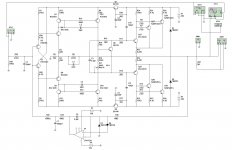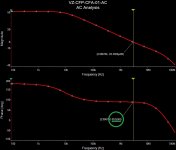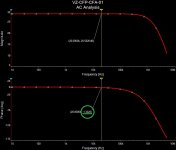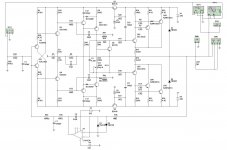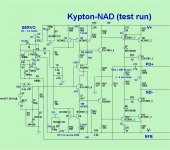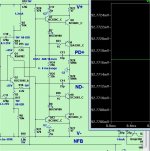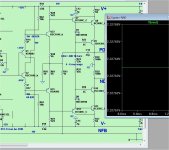It started as testing of some parts of the circuit...
Evil diamond at the input... Evil CFP at the output...
Then I have put an asymmetric-current-mirror VAS in between - and voilà! It's not that evil any more
A little bit of compensation fine-tuning and everything looks very cool.
Low THD, wide bandwidth, high speed, 89 degrees phase margin, excellent closed loop phase response. Curves are like in a "schoolbook"
I simulated a lot of different circuits and I can tell you - it's not often, you can see such "clean" ones.
I publish it as an initial development. If somebody is keen to design a PCB and try it out - you are welcome. Don't forget to add the Zobel/Thiele network at the output and some more capacitors at the rails (I omit them while simulating).
Vbe multiplier has to be placed on the local heatsink together with the drivers (separate from the main one with the outputs).
It runs pretty cool - low biased output stage does not dissipate too mush heat. THD is rather low (0.003% @ 1KHz) even at 20-30mA per output pair.
The pictures are:
1) Simulated schematic;
2) AC analysis (method by Bob Cordell) - note the curves shape and the phase margin value (89.5 degrees);
3) Closed loop response - note phase shift at 20 KHz (-1.3 degrees).
Cheers,
Valery
Evil diamond at the input... Evil CFP at the output...
Then I have put an asymmetric-current-mirror VAS in between - and voilà! It's not that evil any more
A little bit of compensation fine-tuning and everything looks very cool.
Low THD, wide bandwidth, high speed, 89 degrees phase margin, excellent closed loop phase response. Curves are like in a "schoolbook"
I simulated a lot of different circuits and I can tell you - it's not often, you can see such "clean" ones.
I publish it as an initial development. If somebody is keen to design a PCB and try it out - you are welcome. Don't forget to add the Zobel/Thiele network at the output and some more capacitors at the rails (I omit them while simulating).
Vbe multiplier has to be placed on the local heatsink together with the drivers (separate from the main one with the outputs).
It runs pretty cool - low biased output stage does not dissipate too mush heat. THD is rather low (0.003% @ 1KHz) even at 20-30mA per output pair.
The pictures are:
1) Simulated schematic;
2) AC analysis (method by Bob Cordell) - note the curves shape and the phase margin value (89.5 degrees);
3) Closed loop response - note phase shift at 20 KHz (-1.3 degrees).
Cheers,
Valery
Attachments
It started as testing of some parts of the circuit...
Evil diamond at the input... Evil CFP at the output...
Then I have put an asymmetric-current-mirror VAS in between - and voilà! It's not that evil any more
A little bit of compensation fine-tuning and everything looks very cool.
Low THD, wide bandwidth, high speed, 89 degrees phase margin, excellent closed loop phase response. Curves are like in a "schoolbook"
I simulated a lot of different circuits and I can tell you - it's not often, you can see such "clean" ones.
I publish it as an initial development. If somebody is keen to design a PCB and try it out - you are welcome. Don't forget to add the Zobel/Thiele network at the output and some more capacitors at the rails (I omit them while simulating).
Vbe multiplier has to be placed on the local heatsink together with the drivers (separate from the main one with the outputs).
It runs pretty cool - low biased output stage does not dissipate too mush heat. THD is rather low (0.003% @ 1KHz) even at 20-30mA per output pair.
The pictures are:
1) Simulated schematic;
2) AC analysis (method by Bob Cordell) - note the curves shape and the phase margin value (89.5 degrees);
3) Closed loop response - note phase shift at 20 KHz (-1.3 degrees).
Cheers,
Valery
Valery if you increase the current mirrors degeneration resistor you will get lower noise.
Damir
Valery if you increase the current mirrors degeneration resistor you will get lower noise.
Damir
Good point Damir. Although, I will have to increase both of them to maintain the same gain.
Brilliant circuit, Valery. It's simpler than others you have shown us, but the phase shift and margins are very good. Like you, I like diamond buffers, and I like CFPs too. I believe Damir's circuits are very good too - from where I see that is - you are both in the same complementary school.
I really liked your hybrid circuits, too. I have done these and found that they can sound absolutely wonderful, combining the best aspects of SS and tubes.
You have a bit of work though to lay it out, then start the listening tests.......
Congratulations!
Hugh
I really liked your hybrid circuits, too. I have done these and found that they can sound absolutely wonderful, combining the best aspects of SS and tubes.
You have a bit of work though to lay it out, then start the listening tests.......
Congratulations!
Hugh
OK, this one is already close to the way it will be live-tested.
Removed the mirrors, increased the VAS resistors and - most important - added super-pairs. Slightly increased linearity and - as a bonus - excellent clipping with rounded corners.
- excellent clipping with rounded corners.
No choice now I have to try it
I have to try it 
Removed the mirrors, increased the VAS resistors and - most important - added super-pairs. Slightly increased linearity and - as a bonus
No choice now
Attachments
Brilliant circuit, Valery. It's simpler than others you have shown us, but the phase shift and margins are very good. Like you, I like diamond buffers, and I like CFPs too. I believe Damir's circuits are very good too - from where I see that is - you are both in the same complementary school.
I really liked your hybrid circuits, too. I have done these and found that they can sound absolutely wonderful, combining the best aspects of SS and tubes.
You have a bit of work though to lay it out, then start the listening tests.......
Congratulations!
Hugh
Thank you Hugh. You know, this one started as "nothing serious". And then it started showing the potential
I like Damir's work in this area too - deeply worked-through designs...
My last hybrid (TubSuMo) is super-fast - it will be really interesting to compare it with something like this.
Cheers,
Valery
OK, this one is already close to the way it will be live-tested.
Removed the mirrors, increased the VAS resistors and - most important - added super-pairs. Slightly increased linearity and - as a bonus- excellent clipping with rounded corners.
No choice nowI have to try it

You can convert input diamond to the super pairs too, I prefer them as I can use lower voltage BJTs then with higher hfe, low noise and easier to find.
Damir
You can convert input diamond to the super pairs too, I prefer them as I can use lower voltage BJTs then with higher hfe, low noise and easier to find.
Damir
Aaaah... interesting - thank you
Evil diamond at the input...
Lazy cat won't like it !
Disadvantages -
- bad pssr
-no real advantage over a "vssa" (single IP pair) based CFA.
Advantages -
-can select different pairs for both diamond/CFB devices.
If you servo the diamond input , imagine the offset with a servo failure.
I actually went with servo'ed mirrors (like kypton-C) on this CFA and
can get only 1V offset with a full servo failure.
Thimios already built this with a Hawksford as VAS.
I also used the "super VAS" (below) .... the "vssa" or this input configuration
have absolutely the same THD and distortion content( 8-11ppm/ 20k 100w)
.
65-70db psrr the way it is. Add the zener supplies + mirrors for -80db or
better.
I feel we need to come up with something more "radical" to beat the
simple "vssa" type input stage. (VERY hard to beat - simplicity vs. performance).
PS - would of just posted this amp - but the "villagers" don't like
the diamond.
OS
Lazy cat won't like it !
Disadvantages -
- bad pssr
-no real advantage over a "vssa" (single IP pair) based CFA.
Advantages -
-can select different pairs for both diamond/CFB devices.
If you servo the diamond input , imagine the offset with a servo failure.
I actually went with servo'ed mirrors (like kypton-C) on this CFA and
can get only 1V offset with a full servo failure.
Thimios already built this with a Hawksford as VAS.
I also used the "super VAS" (below) .... the "vssa" or this input configuration
have absolutely the same THD and distortion content( 8-11ppm/ 20k 100w)
.
65-70db psrr the way it is. Add the zener supplies + mirrors for -80db or
better.
I feel we need to come up with something more "radical" to beat the
simple "vssa" type input stage. (VERY hard to beat - simplicity vs. performance).
PS - would of just posted this amp - but the "villagers" don't like
the diamond.
OS
Attachments
Servo's aren't needed ... but they are nice. They use whatever is in the
junkbox and still report 1-2 mv offset (no "trimmin' involved).
That don't sound right. Vfa= 600k - 1.5meg UGBW and Cfa= 2-3Mhz UGBW.
More = not enough phase margin ???
OS
junkbox and still report 1-2 mv offset (no "trimmin' involved).
The unity gain bandwidth is three megahertz (post #1)? That is one of the lowest UGBW values I've ever seen for a current feedback amplifier. The voltage feedback amplifiers in Cordell's and Self's books generally have UGBW between ten and forty megahertz.
That don't sound right. Vfa= 600k - 1.5meg UGBW and Cfa= 2-3Mhz UGBW.
More = not enough phase margin ???
OS
CFA offset
"Raw" CFA simulations ... (no servo)
(below 2) - diamond based CFA offset / 2.3v.
(below 1) - no diamond - with caps ... WAY less offset / 92mv.
CFA = offset. Both are much worse than their VFA counterparts.
I prefer 1-2mv .
.
OS
"Raw" CFA simulations ... (no servo)
(below 2) - diamond based CFA offset / 2.3v.
(below 1) - no diamond - with caps ... WAY less offset / 92mv.
CFA = offset. Both are much worse than their VFA counterparts.
I prefer 1-2mv
OS
Attachments
Last edited:
It's the loop gain - not the closed loop unity gain frequency.
3 MHz is about right.
Ahh - open loop ...
I've seen CFA's go right to device Ft (<50mhz) !
OS
See Cordell p.47.
The open loop unity gain bandwidth for most audio power amplifiers usually lies between 4 MHz and 40 MHz.
At 26 dB loop gain (i.e. 20X), the "gain crossover frequency" (where the DC gain intersects the open loop gain) usually lies between 0.2 MHz and 2.0 MHz.
See Figure 2.15 for a Bode plot showing unity gain bandwidth of 10 MHz.
The open loop unity gain bandwidth for most audio power amplifiers usually lies between 4 MHz and 40 MHz.
At 26 dB loop gain (i.e. 20X), the "gain crossover frequency" (where the DC gain intersects the open loop gain) usually lies between 0.2 MHz and 2.0 MHz.
See Figure 2.15 for a Bode plot showing unity gain bandwidth of 10 MHz.
Last edited:
Yes, open loop UGBW is around 3MHz, but it's pretty much controlled by compensation (combination of lag and lead ones). Otherwise it would be much higher, but then the margins would be not so good and too much dependent on active devices selection/tolerance - not good in terms of "repeatability" 
No servo needed with a diamond input - that's the great advantage!

Yes, it's rather stable, but normally needs to be trimmed initially (tolerance, npn/pnp difference, etc.).
I just like it "automated"
Evil diamond at the input...
Lazy cat won't like it !
Disadvantages -
- bad pssr
-no real advantage over a "vssa" (single IP pair) based CFA.
Advantages -
-can select different pairs for both diamond/CFB devices.
If you servo the diamond input , imagine the offset with a servo failure.
I actually went with servo'ed mirrors (like kypton-C) on this CFA and
can get only 1V offset with a full servo failure.
Thimios already built this with a Hawksford as VAS.
I also used the "super VAS" (below) .... the "vssa" or this input configuration
have absolutely the same THD and distortion content( 8-11ppm/ 20k 100w)
.
65-70db psrr the way it is. Add the zener supplies + mirrors for -80db or
better.
I feel we need to come up with something more "radical" to beat the
simple "vssa" type input stage. (VERY hard to beat - simplicity vs. performance).
PS - would of just posted this amp - but the "villagers" don't like
the diamond.
OS
Servo'ed mirrors - cool

I never had a servo failure - maybe that's where my confidence in slightly "abusing" it comes from
I'd like to see its noise/ripple level on a live prototype. The one I've got on VFA TubSuMo prototype is somewhat an overkill - it's really imposssible to hear if the amp is on or off
Something more radical - sounds good to me
- Status
- This old topic is closed. If you want to reopen this topic, contact a moderator using the "Report Post" button.
- Home
- Amplifiers
- Solid State
- Cool simple "clean" CFA
